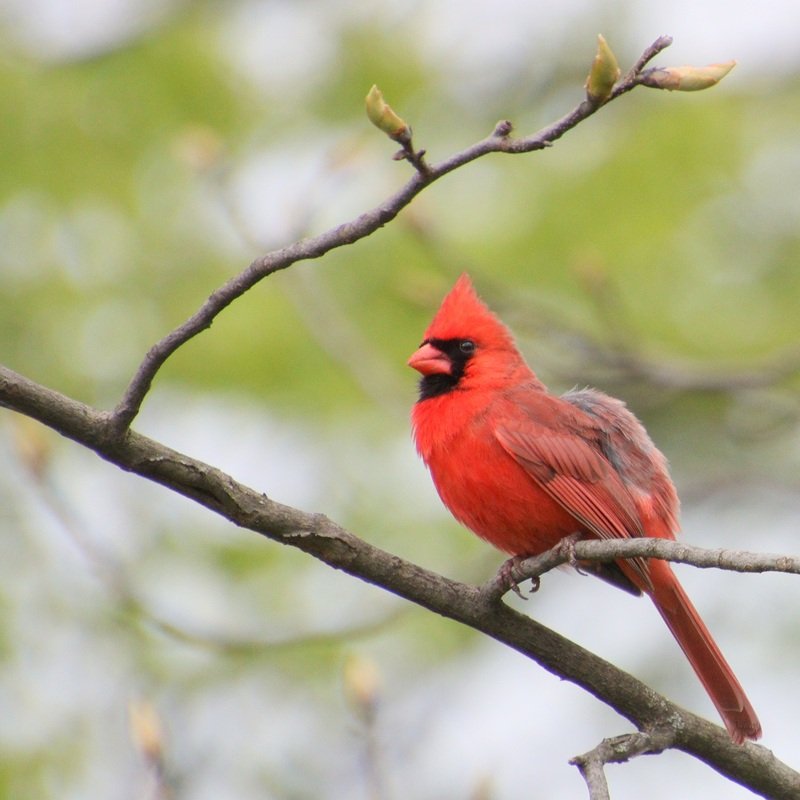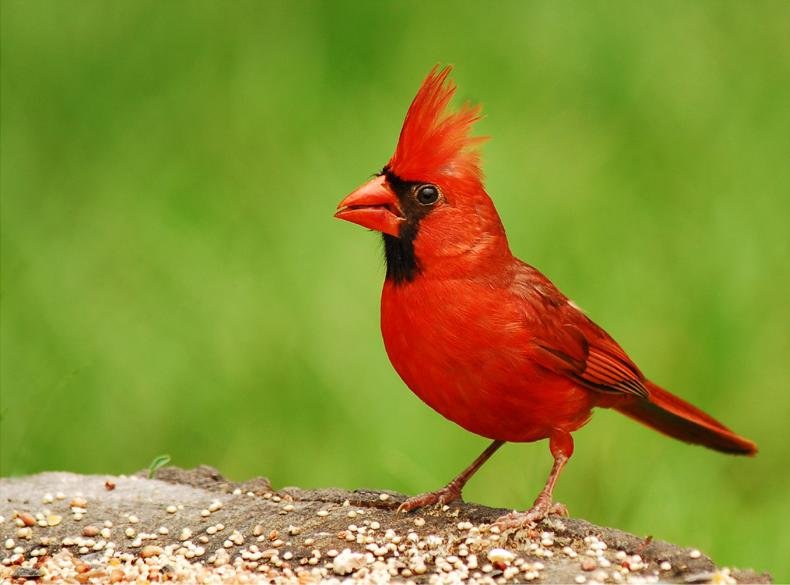The Cardinalis cardinalis or commonly known as Northern Cardinal is a species of bird in the family of Cardinalidae. It is also called the redbird, common cardinal, red cardinal, or just cardinal. Cardinal refers to the Roman Catholic cardinals, who wear red robes and caps. The northern cardinal’s common and scientific names come from this. The common name refers to the species’ range, as it is the northernmost of the cardinal species.
Quick Overview: Cardinalis Cardinalis – Northern Cardinal
Body size: Around 7.5-9.25 in (19-23 cm) in length and weighed about 52 g (1.83 oz)
Main colors: Red, Black, Light-Brown, Greenish-Brown, Orange-Red
Range: Eastern United States
Migratory Bird: No
Best time of the year to see in the U.S.: All year (January – December)
Conservation Status: Least Concern
Northern cardinal Description
Northern cardinals are medium-sized songbirds that live in North America. Unless they are wearing a black mask on their faces, males are a bright red color. Females are light brown or light greenish-brown in color, with reddish highlights, and they do not have a black mask like the males do (but parts of their face may be dark). Both males and females have thick, orange-red, cone-shaped bills, a long tail, and a distinctive crest of feathers on the tops of their heads, which distinguishes them from other birds in the same family. Males are slightly larger in stature than females, but both are similar in size.
Size
This medium-sized bird is 7.5-9.25 in (19-23 cm) in length and weighed about 52 g (1.83 oz). Their wingspan could range up to 10-12 in (25-30 cm).
Feeding
These cardinals are opportunistic feeders, which means they will take advantage of any situation. They also eat insects, fruits, and snails, among other things. Grapes are commonly peeled in their bill to remove the pulp and seeds and discard the skin, which they do in their bill.
Habitat
Do you know that the northern cardinal is a songbird with a strong sense of territoriality? As a means of defending his territory, the male sings in a loud, clear whistle from the top of a tree or another elevated location. He will chase away any other males who attempt to enter his territory. Typical habitats include forest edges, hedgerows, lowlands, suburban areas, swamps, streamside thickets, and the vegetation surrounding homes and other structures.
Behavior
Cardinals are non-migratory birds that live in the United States. The majority of cardinals live within a mile of their place of birth. Cardinals are songbirds, and the male uses his call to entice a female to mate with him.
In contrast to the majority of northern songbirds, the female also sings. In what appears to be a call to her mate, females will frequently sing from the nest. Cardinal pairs have song phrases in common that they sing together. On the first sunny days of late winter, if you listen carefully, you may be able to hear the song of the cardinal. A short “chink” sound or the words “cheer, cheer, cheer” are used to describe it.
Cardinalis cardinalis Scientific Classification
- Kingdom: Animalia
- Phylum: Arthropoda
- Subphylum: Chelicerata
- Class: Aves
- Order: Passeriformes
- Family: Cardinalidae
- Genus: Cardinalis
- Species: Cardinalis cardinalis
Subspecies
There are 19 subspecies of these species namely : C. c. cardinalis , C. c. affinis Nelson, C. c. canicaudus Chapman, C. c. carneus, C. c. clintoni, C. c. coccineus Ridgway, C. c. flammiger, C. c. floridanus, C. c. igneus, C. c. littoralis , C. c. magnirostris, C. c. mariae , C. c. phillipsi, C. c. saturatus, C. c. seftoni, C. c. sinaloensis, C. c. superbus, C. c. townsendi, C. c. yucatanicus
Best time of the year to see
In the United States, the best time of year to see these birds is all year round, regardless of the season. This refers to any month of the year from January to December.
Other common names
It is also referred to as the redbird, common cardinal, red cardinal, or simply called the cardinal in some circles.
Distribution of the Northern cardinal in the USA
The northern cardinal is the state bird of seven states in the United States, more than any other species. These states are Illinois, Indiana, Kentucky, North Carolina Ohio, Virginia, and West Virginia, however, in each case, the bird is simply referred to as “cardinal” by the state in question. Also, a candidate to be named the state bird of Delaware was defeated by the Delaware Blue Hen in the process.
These birds can also be found in the following states in the United States – Alabama, Alaska, Arizona, Arkansas, Colorado, Connecticut, Delaware, Florida, Georgia, Hawaii, Iowa, Kansas, Louisiana, Maine, Maryland, Massachusetts, Michigan, Minnesota, Mississippi, Missouri, Nebraska, New Hampshire, New Jersey, New Mexico, New York, North Dakota, Oklahoma, Pennsylvania, Rhode Island, South Carolina, South Dakota, Tennessee, Texas, Vermont, Wisconsin.



